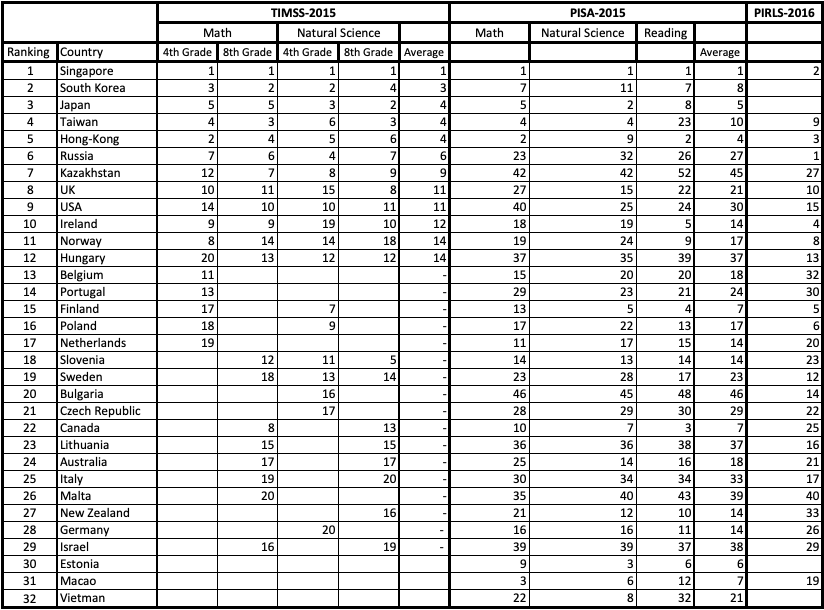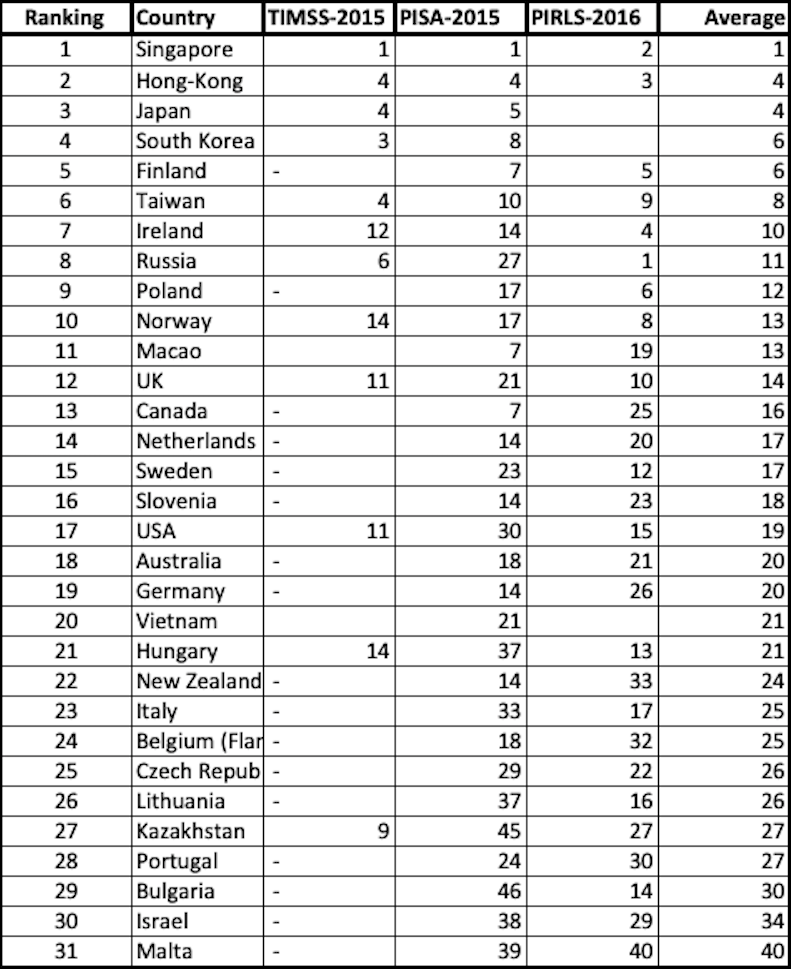Assessing Kazakhstan’s future prospects, we should keep in mind that this state is positioned among the top smartest countries. The results of the international standardized tests provide a cause for optimism. However, the future prospects may turn out to be cheerful only for a small elite group of «the enlightened» that will be maximally eager to preserve the political status quo.
In January 2019, website Vouchercloud published a rating of the world’s «smartest countries». Despite the site’s specialization — providing coupons for goods’ purchasing, the publication turned out to be a very resonant one and all kinds of different media have republished it. This is not surprising since everyone is certain that the future of Earth civilization and its individual nations is determined by the level of knowledge and the skills of the people. With that, the authors were able to not only show the picture of the past and the present but also to peek into the future.
The future is in Asia
The rating has the form of a simple composition consisting of three additives each of which represents a country’s position in different rankings: in re the number of the Nobel Prize winners (reflects the past achievements), in re the IQ level (reflects the present state) and in re the evaluation of the school tests (reflects the future prospects).
The final picture has turned out to be quite a remarkable one.
In the general rating of the 25 top smartest countries, the leading positions belong to the states of the Western Europe and North America. But this is a tribute to history: their leadership can be explained by the first positions on the Nobel Prize winners’ list, in other words, by the historic achievements. In the course of several centuries, the Western world has de-facto possessed the monopoly for knowledge, for both research and the distribution of its results.
Distribution of Nobel Prize Winners on Country-by-Country Basis

However, if we are to take away the historic factor and look at the present state of affairs, the picture changes. In the general rating in re the IQ level, all the top positions are occupied by the South-East Asian countries.
IQ Average Score on Country-by-Country Basis

The same trend can be observed in the third rating — the list of the top counties in re the analytical school tests.
Ranking of Leading Countries Based on Different Tests

In other words, Asia is already shooting ahead. However, at this point, it has not been able to transform the rapidly growing human capital into the global leadership.
As for Kazakhstan, it has not received a spot in the top smart countries’ rating compiled by Vouchercloud. The reasons for that lie in the complicated past and the unimpressive present. In the literal sense of the word.
The achievements of the Nobel Prize winners that had received the awards at the times of the Russian Empire and the Soviet Union have been attributed to the modern Russia. Thus, Kazakhstan has automatically lost its «smart» past. As for the present whose level is determined by the level of the IQ tests, the country is ranking above the middle. It holds the 48th place with the average score of 92 (1990-2010).
As for Kazakhstan’s future, in the rating, it looks more optimistic if its prospects are assessed according to the results of international standardized tests.
PISA, TIMSS and PIRLS
Kazakhstan is actively participating in several international researches that can be used for the purpose of comparative analysis. We have analyzed the results of three tests — PISA, TIMSS and PIRLS — in order to determine Kazakhstan’s place in the world’s rating. Essentially, we have tried to predict the direction of the country’s development in the future. All other things being equal, the success of the education system creates the foundation for sustainable development of the modern civilization.
TIMSS (Trends in Mathematics and Science Study) allows to evaluate the quality of mastering the academic program in math and natural science by the schoolchildren of the 4th and 8th grades.
PIRLS (Progress in International Reading Literacy Study) allows to evaluate the schoolchildren’s reading proficiency.
PISA (Programme for International Student Assessment) is a test that evaluates the ability of 15-year-old schoolchildren to put their knowledge to use when solving practical problems.
Predictably, the leading positions here belong to the South-East Asian countries. This is yet another confirmation that the center of the world civilization is to shift invariably which will have some unavoidable (albeit unpredictable) geopolitical consequences.
To determine Kazakhstan’s bottom-line position in our education rating, we have ranked the leading countries according to the results of the tests, calculated the average score for the two of them (TIMSS and PISA) and then calculated the average score using the data received and the results of the PIRLS tests. As a result, according to our estimates, Kazakhstan occupies the 27th place in the world «smart youth» rating.
This is a good result that shows that the country has got the prospects for development in the future.
However, behind the impressive average result, there hides an even more impressive dispersion between different tests and within each test as well as between different groups of children.
The TIMSS results have turned out to be most successful for Kazakhstan. The country holds the 9th place in the world in terms of the mathematical and the natural science knowledge which confirms the effectiveness of the fundamental science learning based on the traditions of the Soviet school. The results of the math mastery of the Kazakh 4th-graders are significantly higher than the world’s average.
On the other hand, based on the results of the PISA test, Kazakhstan holds the 45th place in the rating. In other words, having received excellent knowledge, the Kazakh schoolchildren encounter the problem of using it when solving practical problems. One can even say they are too smart for their own good.
PIRLS determines not simply an ability to read but to understand and analyze a text. In re this test, Kazakhstan holds the 27th position in our rating.
Final Ranking of “Smart” Countries Based on School Tests Results

Source: kz.expert’s calculations
A matrix of contradictions
The differences in the results are especially evident between the urban and the rural areas, in terms of the language in which education is recieved as well as in terms of the tested schoolchildren’s social standing. Nothing surprising about that. However, in the Kazakh context, these differences have a clearly-defined regional nature.
The Almaty-city schoolchildren showed the best results in the mastering of the math problems (44%). The 4th-graders of the South Kazakhstan region, the Atyrau, Mangistau and Almaty regions demonstrated the worst results.
The Almaty-city primary school is also on the top in terms of natural science. As for Mangistau and the South Kazakhstan region, the share of the schoolchildren that did not complete the task is twice as big as the country’s average.
In Kazakhstan, the tests can be taken in two languages, Russian and Kazakh. The Russian-language-educated schoolchildren hold the top positions in Almaty, Kyzylorda, Aktobe and Zhambyl regions. The Kazakh-language-educated 4th-graders of the Aktobe and Pavlodar regions show the results that are significantly lower than the achievements of their Russian-language-educated peers.
At the same time, the Kazakh-language-educated 4th-graders of the Karaganda region showed better results in the math tests in comparison with their Russian-language-educated peers.
The biggest discrepancy of the results in the last group has turned out to be between Almaty (the city-leader) and the Pavlodar region (the outsider region).
As we can see, the differences posses not a linear but a matrix nature; the pairs of opposites are formed in the two-dimensional space of the languages and the regions. In practice, it means that the complex bilingual structure of Kazakhstan has become intertwined with the regional structure. However, no one is in a hurry to study this plexus. We can only assume that the regions are forming the language clusters that integrate the best students regardless of their native tongues. Correspondingly, the outsiders demonstrate the worst results regardless of the language they consider their native.
The tests results, the authors believe, have elicited the benefits of the bilingualism. The children that are educated in one language but speak another language at home show better results. And this gap widens as they grow up.
The enlightened inequality
The international program of education testing bumps up against the national practices of conducting such tests in Kazakhstan.
When the Kazakh Ministry of Education published the results of the 2015 PISA test on its website, the media noted that Kazakhstan was absent from the map showing the PISA-2015 results on the OECD website.
As Informburo.kz found out, this had to do with a huge jump in the schoolchildren’s knowledge that is inconceivable for a one-year period. The OECD explained this jump by the assistance provided by the teachers to the students during the test.
If it is so, then, unfortunately, such tests should be treated as the Olympic games where the task of improving the national results plays an important role for any government and some of them are eager to violate any rule to achieve these results. This is a sad yet evident fact of life.
The truth, however, may turn out to be even uglier than that. The thing is that the majority of the children that took the test in 2015 consisted of the students of the Nazarbayev Intellectual Schools. Out of 5780 of the 15-year-old students, 2061 were from there. Thus, the test did not demonstrate that Kazakhstan had got smart kids and, therefore, the county can hope for a better future. It showed that the country had a smart elite with an elite education, and it is this elite that can count on the bright future. See the difference?
The fact that Kazakhstan is forming a higher cast of the educated can be confirmed not only by the tests results but by the entire structure of the country’s education expenditures. According to the estimates of the Sandzh research center’s Director Zhanar Dzhandosova, Nazarbayev University and the Nazarbayev Intellectual Schools take up the major part of the budget expenditures for education leaving a miserable amount to ordinary schools.
The existence of this kind of education «ecosystem» allows to economize in a significant way. The expenditures for education in Kazakhstan constitute only 3,7% of the GDP (in Ukraine, for instance, they constitute 6,7%). Therefore, it is vitally important for the operators of this system that it demonstrates good results.
Knowledge is not only power but domination
In Kazakhstan, the economic model of «education for the select few» is forming not because the ill-wishing people want to create it. It entirely corresponds to the logic of the resource distribution in the economy oriented towards servicing a small elite group that has the monopoly for distributing the resource rent income.
The theory of the correlation between the economic and education systems was developed by Finnish political analyst Tatu Vanhanen who presupposed that the intellectual resource had, throughout history, been an important element of exerting control over a society. In the modern civilization, it has become the central element of the system. If the resources are concentrated in the hands of a small group of people, this group, according to Vanhanen’s theory, will try to preserve the status quo by every means possible since widening the circle of the educated invariably leads to a partial loss of their resources and statuses.
Vanhanen believed that a wide distribution of knowledge will not allow the ruling system to repress its opponents and preserve the hegemony.
Consequently, the simple growth of the national income (even per capita) does not play a particularly important role in the development of the political and social systems. The main factor of their democratization lies in the distribution of the economic, intellectual and other resources in a society.
Vanhanen confirms his theory via analyzing the empirical data collected in re different countries. And his conclusions, in their entirety, correspond to the conclusions of the comparative study devoted to the results of the international testing in Kazakhstan — «the national education system does not perform the role of a «social lift». It only intensifies the existing divide in the society functioning as a «separator».
The situation is worsened by the correlation between the level of the parents’ education and the results shown by the children. In other words, literacy (and illiteracy) are de-facto inherited within the family. And this factor intensifies the income inequality.
The enlightened democracy
This is where the principal difference between today’s Kazakhstan and the Kazakhstan of the beginning of the 2000s lies. The 2000s was the time when an attempt to launch the country’s democratization program from below was made.
In the beginning of the 2000s, together with Russia and Belarus, Kazakhstan was in the troika of the CIS leaders in terms of the accumulated human capital (per capita).
Despite the obvious problems of the 1990s (the massive emigration, the economic recession and the social degradation of the regions), Kazakhstan had managed to preserve the basis of its civilization. Its leadership looked particularly impressive considering that, at the moment of the USSR’s disintegration, 80% of the accumulated human capital was accounted for by three Soviet republics (Russia, Belarus and Ukraine).
The reason for the accelerated accumulation of the human capital in Kazakhstan lied in the democratic system of its distribution in the society that was formed back in the USSR and kicked started the development of the new elite keen on the wide spread of knowledge in society.
It is for this reason that Mukhtar Dzhakishev once expressed a paradoxical idea that Kazakhstan needs to sell out all the national uranium reserves as soon as possible. The necessity for this extravagance was explained in a simple way: the physicist believed that, after (quite a foreseeable) while, the humankind will discover a way to manage the thermonuclear fusion which will give an inexhaustible power source to the people. This will reduce the value of all the Kazakh uranium reserves to nothing. And increase the value of the human capital.
The geopolitics of knowledge
The issue, of course, does not lie in the correctness of the technological prognostications. It lies in the general principal best described by Minister of Oil and Mineral Resources of Saudi Arabia Zaki Yamani when he reminded the experts predicting the collapse of the civilization due to the exhaustion of the oil reserves that the stone age did not end because the world ran out of stones.
For Yamani, these were not just words. By using the oil price leverages, the ex-minister had managed to kick out of the geopolitical orbit Saudi Arabia’s main competitors at the oil market, Iran (1979) and the Soviet Union (1986).
Any resource-based wealth may turn into a mirage at a sharp turn of the civilization history. The only exception is the human capital. This resource allows a nation to find a place in the world’s history whatever turn the events may take simply because it relies on the proactive and educated people each of whom is trying to find themselves in the new conditions.
Basically, it was this factor that allowed Kazakhstan to survive after the collapse of the USSR when the existence of its own proactive entrepreneurs had helped the country not to turn into a resource colony. Now, however, we are observing an opposite trend. The across-the-board «diversification» on paper turns out to be a total monopoly in reality. And education has to fit into the process.




